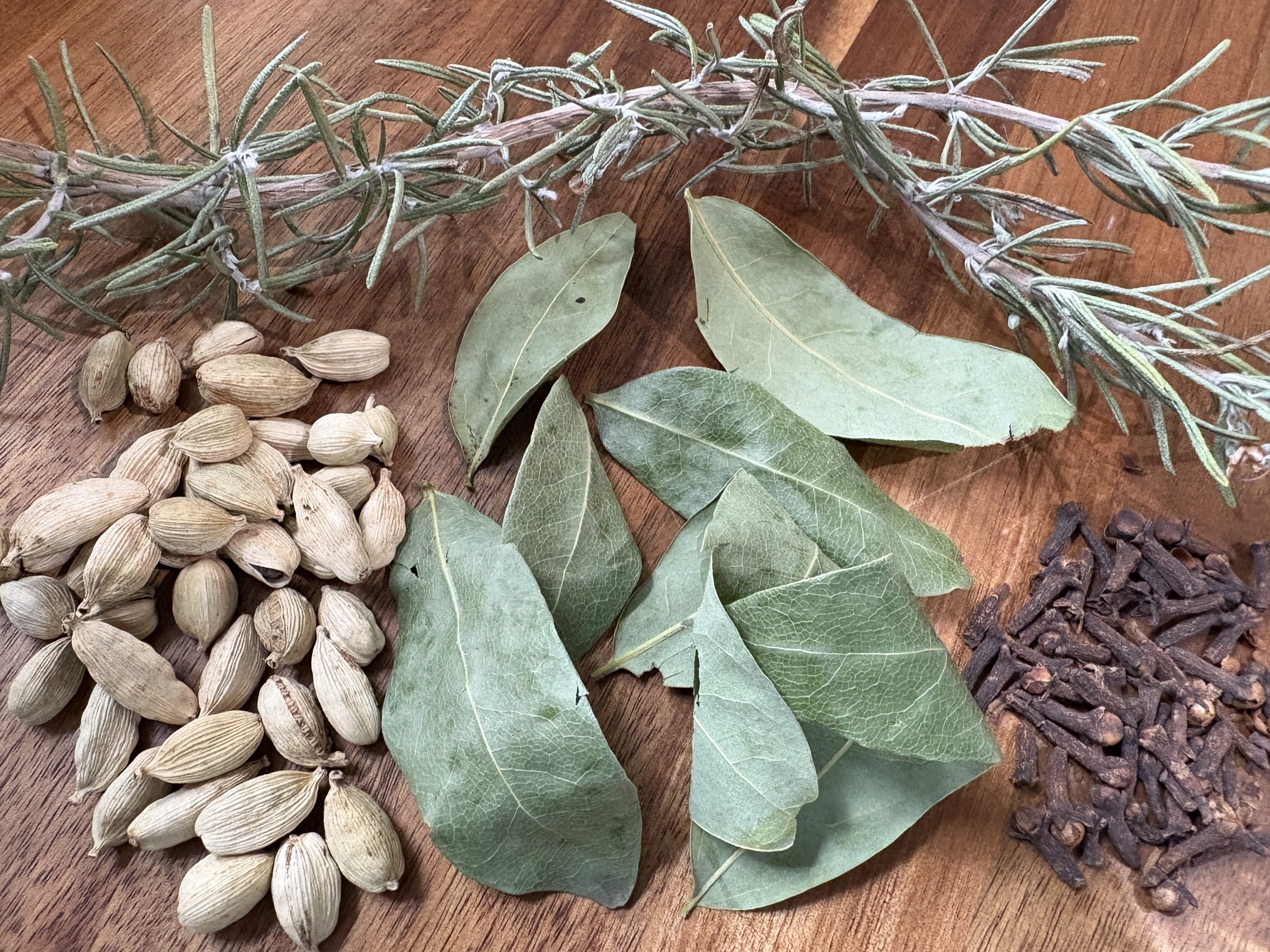Making Herbal Syrups
Herbal Syrups are made by combining an herb, water, and a sweetener (usually sugar). They are a thick, sweet consistency and are a great way to flavor an herbal formula or make it more palatable, especially when using unpleasant-tasting herbs.
I will begin by looking at simple syrups and then add in the herbal component. I will offer suggestions about herbs that can be used in syrups, concluding with suggestions for different ways to use herbal syrups.
First, we will discuss making a simple syrup. There are many recipes for simple syrup, the difference is the ratio of sugar to water. Although one can use other ingredients, distilled water and pure white sugar have no minerals and will therefore make a more stable syrup.
The method of making a simple syrup is the same regardless of the amount of sugar used. Using sterilized equipment, combine the water and sugar in a medium saucepan and heat slowly until the sugar is dissolved. You can use a ratio of 1:1, 1:2, or 1:3 water to sugar, depending on the desired sweetness. The more sugar you use, the thicker, sweeter, and more stable your syrup will be. Pour the syrup into a sterilized jar and cool before using. Below are three recipes to make a simple syrup.
lavender, hibiscus and ginger simple syrups
Simple Syrup Recipes:
Recipe#1 (“rich” or “heavy” simple syrup):
2 parts sugar
1 part distilled water
Recipe#2:
This recipe is less sweet and also less stable.
1 part sugar
1 part distilled water
Recipe#3:
This final recipe is even less sweet and less stable.
1 part sugar
2 parts distilled water
Use this formula soon after making it, as it will grow mold over time.
Herbal Syrups
If you’re having trouble taking an herb due to its off-putting taste, consider adding herbal syrups to your repertoire. They are delicious and can add to both the pleasure and the compliance of taking herbal remedies. Herbs can be added to any simple syrup recipe. Fresh and dried herbs should be handled in different ways, due to the water content of the fresh plant.
Note that to preserve your herbal syrups, they need to be strained well. I like to first strain the herbs through a stainless-steel strainer and then strain the syrup again through a nut milk bag, layered muslin cloth, or unbleached coffee filter. Please see additional preservation suggestions below.
chopping ginger into small pieces
Making a Fresh Plant Herbal Syrup:
There are several ways to make a fresh herbal syrup, including making a cheong, pureeing the herb, or juicing the herb before adding it to the sugar.
Cheong: A cheong is a traditional Korean fruit syrup or preserve.
Use equal parts by weight of your fresh herb and sugar.
Layer the herb with sugar and let it sit.
The sugar is a humectant and will draw out the herb's juices. The juices then dissolve the sugar over time.
Stir daily for two weeks to prevent molding. You can let the cheong sit for as long as three months before straining, and the fermented syrup can “mature” for up to 1 year.
If desired, to prevent fermentation, you can pasteurize the syrup by heating it to 165 degrees and then cooling it quickly in a cold-water bath.
Store in an airtight container in the refrigerator for up to 6 months.
Puree the Herb:
First, dice the fresh herb.
Then mix your herb at a 1:1 ratio by weight with sugar
You can adjust for water content in the herb by adding more sugar to wetter herbs.
Let the mixture sit 24 hours or so at room temperature.
Puree the whole thing in a blender or with an immersion blender.
Strain well, first through a stainless steel strainer and then through a nut milk bag, layered muslin cloth, or unbleached coffee filter. Removing all the sediment will improve preservation.
Juice the herb:
Juice the herb in a juicer. Strain well.
Use equal parts by volume of juice and sugar.
Mix them in a pan on low heat, stirring until thoroughly combined.
Suggested Herbs: ginger, turmeric, citrus, fresh berries or hips, and other herbs with high water content.
Making a Dry Plant Herbal Syrup:
This is a simpler process, as the herbs do not contain extra water, making them easier to work with.
Use one of the simple syrup recipes, depending on how sweet and stable you want your syrup to be.
Add 1/3 of herbs (by volume) to the pan and simmer for 20 minutes
For aromatic herbs, instead of putting them in the pan, place the herbs directly in a jar, pour the simple syrup over the herbs, and seal tightly with a lid.
Pour into a jar and set aside to cool until the mixture is room temperature, shaking the jar occasionally.
Strain well, first through a stainless-steel strainer and then through a nut milk bag, layered muslin cloth, or unbleached coffee filter. Removing all the sediment will improve preservation.
Pour syrup into a clean, sterile jar with an airtight lid.
ginger cheong
Syrup Options:
There are lots of fun options you can try when making herbal syrups. Here are some suggestions.
Instead of white sugar, try other sweeteners such as honey, organic sugar, demerara sugar, brown sugar, agave syrup, rice syrup, etc. Please note that you may need more or less of these sweeteners to achieve the same results. The syrup may also be more likely to crystallize (due to minerals) or not have as long a shelf life.
Lemon juice can be added to “brighten” the flavor, adding a bit of acidity and depth to the recipe. Strain it well before adding it to your syrup.
Use a tea blend, including chai, instead of a single herb.
Add 1-3 teaspoons of vegetable glycerin (to 2 cups of simple syrup) to stabilize the syrup and prevent it from crystallizing. Another option is to cool it quickly in an ice water bath.
Preservation:
There are several ways to lengthen the shelf life of your syrups.
Refrigerate the syrup after making it. This is recommended for all syrups.
Add 5% ethyl alcohol to help preserve the syrup.
Freeze the syrup in ice cube trays.
Can the syrup by sealing in canning jars and boiling in water. Leave an inch of headspace in the jar, seal with a canning lid, and put the jar in a boiling water bath for 20 minutes.
Once the syrup has cooled, add 1/4 ounce of sodium benzoate and 1/16 ounce of citric acid per 32 ounces of syrup.
If a syrup becomes murky, cloudy, or forms mold on the surface, it should be discarded.
Herbs for Simple Syrups:
Allspice (Pimenta dioica)
Anise (Pimpinella anisum)
Anise hyssop (Agastache foeniculum)
Basil (Ocimum basilicum)
Bay leaves (Laurus nobilis)
Bee balm (Monarda spp.)
Bilberry (Vaccinium spp.)
Black, green, or white tea (Camellia sinensis)
Blueberry (Vaccinium cyanococcus)
Cacao nibs (Theobroma cacao)
Cardamom (Elettaria cardamomum)
Chamomile (Matricaria recutita)
Cinnamon (Cinnamomum spp.)
Clary sage (Salvia sclarea)
Clove (Syzygium aromaticum)
Coriander (Coriandrum sativum)
Cranberry (Vaccinium macrocarpon)
Dill (Anethum graveolens)
Elderflower or berry (Sambucus spp.)
Fennel (Foeniculum vulgare)
Ginger (Zingiber officinale)
Hawthorn (Crataegus spp)
Hibiscus (Hibiscus sabdariffa)
Lavender (Lavandula spp.)
Lemon, organic peel (Citrus x limon)
Lemongrass (Cymbopogon citratus)
Lemon verbena (Aloysia citriodora)
Lilac (Syringa spp.)
Linden (Tilia spp.)
Marjoram (Origanum majorana)
Nutmeg (Myristica spp.)
Orange, organic peel (Citrus x sinensis)
Parsley (Petroselinum crispum)
Peppermint and other mints (Mentha spp.)
Pineapple weed (Matricaria discoidea)
Rose petals or hips (Rosa spp.)
Rose geranium (Pelargonium graveolens)
Rosemary leaves (Salvia rosmarinus)
Sage (Salvia officinalis)
Star anise (Illicium verum)
Sumac (Rhus spp.)
Sweet woodruff (Galium odoratum)
Tarragon (Artemisia dracunculus)
Thyme (Thymus vulgaris)
Turmeric (Curcuma longa)
Vanilla (Vanilla planifolia)
Violet (Viola spp.)
cardamom, bay leaves, cloves and rosemary
What to do with the leftover herb:
The leftover herb, also called marc, is still full of yummy goodness! I like to use it in several ways.
Make a shrub by adding vinegar to the herb, letting it sit for a few days, and then straining. Shrubs make great cocktails, mocktails, marinades, and more.
Add the herbs to water, simmer, and make a tea.
Finally, when you are done with the herb, please consider composting it to send it back to the earth (as opposed to the landfill).
Uses for Herbal Syrups:
Herbal syrups are versatile. Add them to beverages, including hot water or a tea to make hot or iced tea, coffee drinks, marinades, cocktails, mocktails, lemonade, and juices. They can also be added to foods such as desserts, fruit salads, pastry glazes, whipped cream, pancake topping, sauces, and dressings. Lastly, they are a wonderful and tasty ingredient to add to your herbal formulas, including pills, syrups, cough drops, oxymels, and elixirs.




